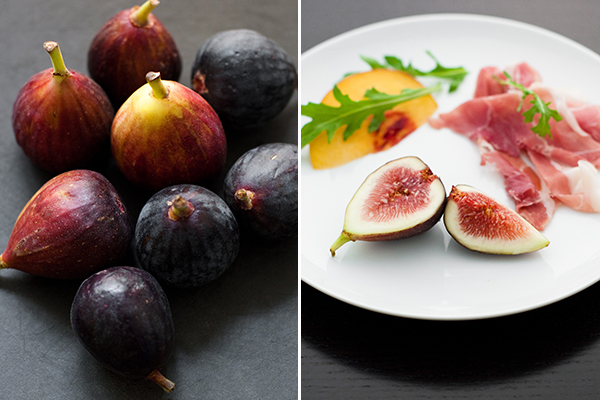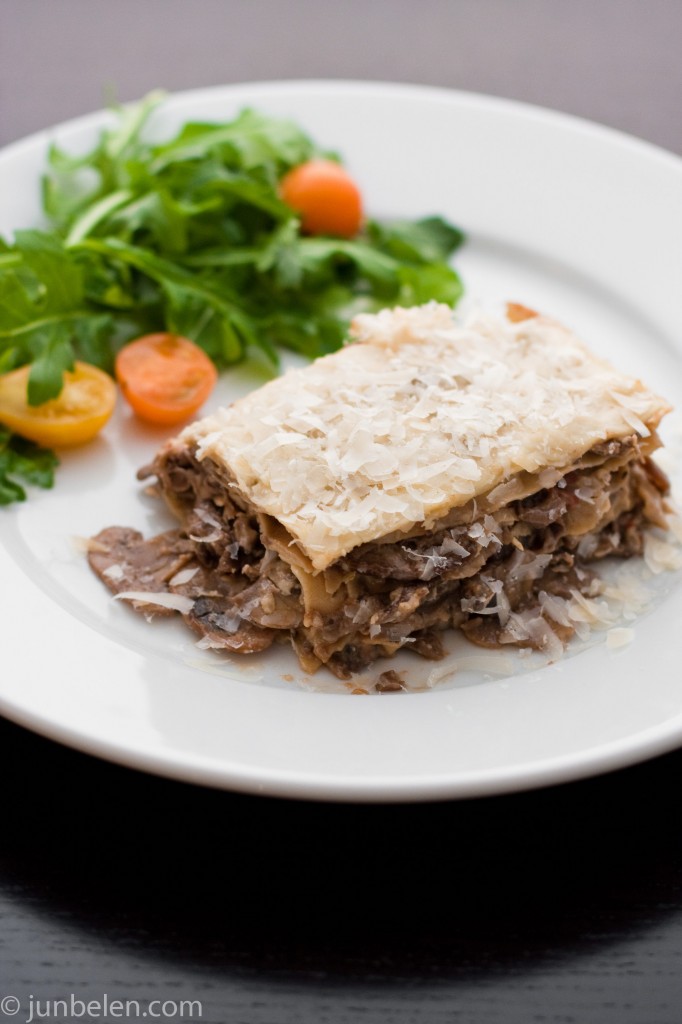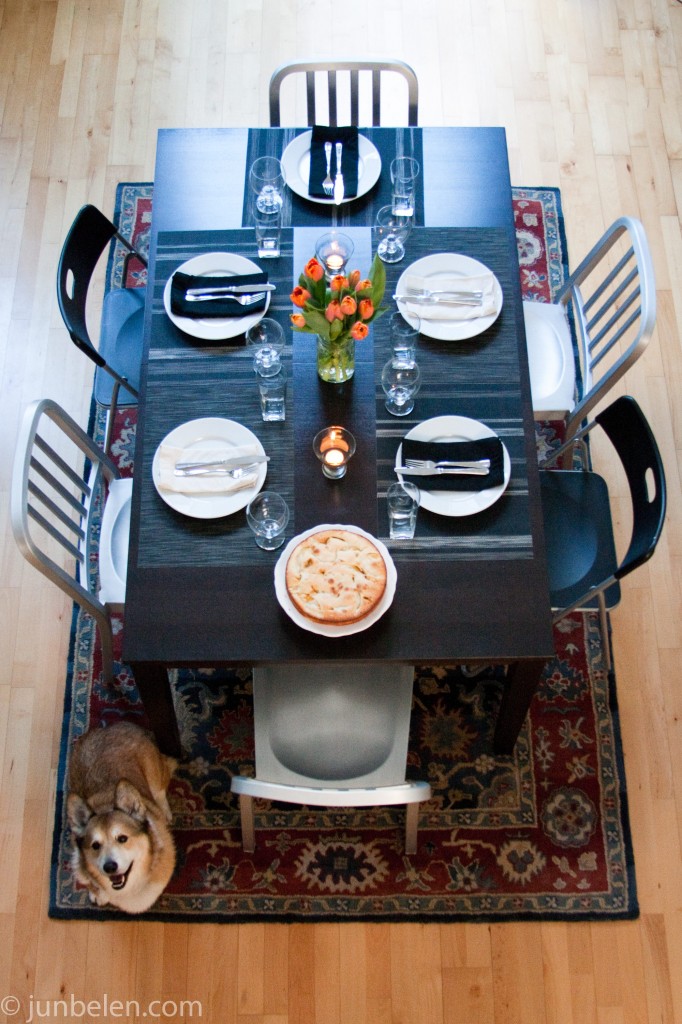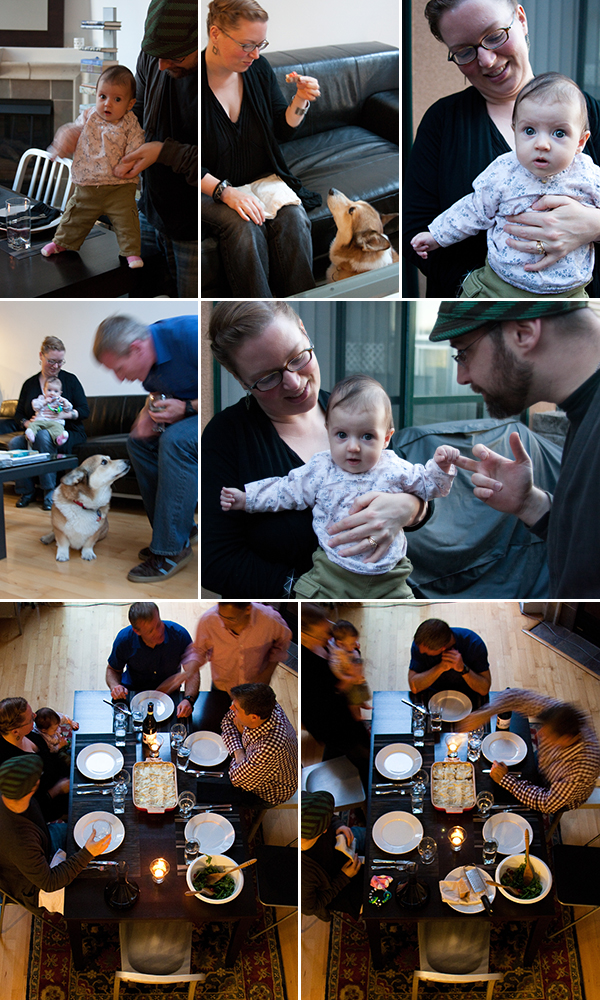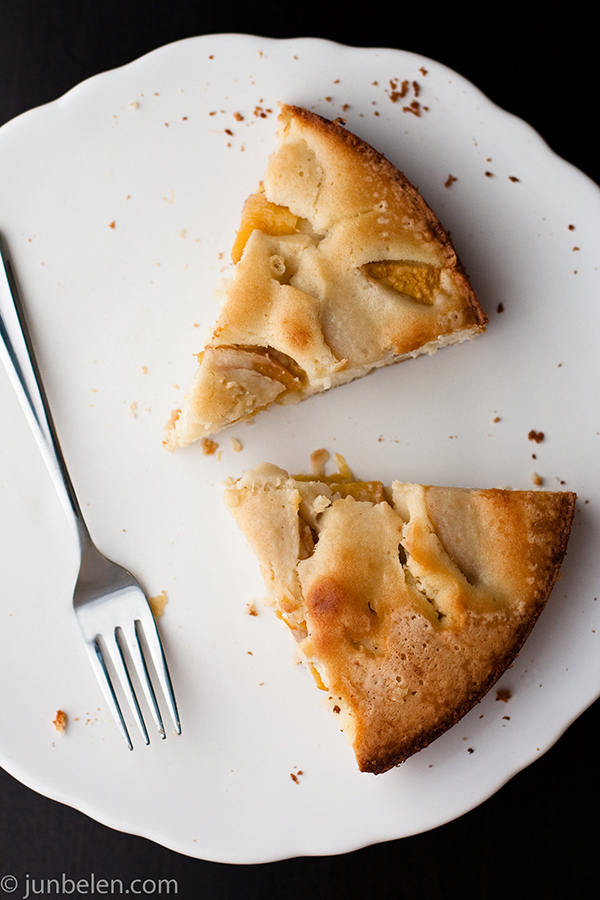A precarious mound of flour, hollowed in the center, filled to the brim with eggs. I started with just flour and eggs and made something I had never made before, something I had always wanted to make.
I mixed them together, very gingerly with a fork at first and then used my fingers and the palm of my hands to work them together into a thick, yellow ball of dough. I pushed forward against it using the heel of my palm, folded it in half, gave it a half turn, and repeated the sequence. Pushed forward, folded, and turned. I kneaded the dough until it was as smooth as a baby’s skin. I cut it into smaller pieces and flattened each piece by running it through a pair of steel rollers that I cranked by hand. I thinned each piece, one after the other, again very carefully, until each piece became delicate, paper-thin strips of fresh pasta.
Making fresh pasta seemed daunting at first but once I gained the confidence — after a dozen or so eggs, and over a pound of flour — I absolutely loved it. It was the intimacy I felt while I mixed the flour and eggs together, while I kneaded and shaped the dough that thrilled me immensely.
My triumph in the kitchen deserved some sort of celebration, I thought. Joe, Mary and their adorable four month old, Hattie, were leaving for Columbus in a week and our good friend Richard celebrated his birthday a couple of weeks ago. Those were reasons to get together, I excitedly told Dennis. And so last week, Dennis and I invited them over for dinner, which would be a sendoff, birthday, and Jun-made-fresh-pasta-from-scratch-let’s-all-celebrate party all rolled into one.
I thought about making fresh fettucine with butter and sage followed by a poached fish or perhaps a roasted chicken. And then I remembered. Thank heavens I remembered that Mary is vegetarian! Forget the fish. Forget the chicken, too. The first thing that popped in my mind was porcini — a rich risotto with porcini mushrooms. But a risotto with pasta (there has to be fresh pasta in the menu!) just didn’t sound right. Then I turned to Marcella Hazan and her beautifully written Essentials of Classic Italian Cooking for inspiration. She writes passionately,
“An Italian meal is a lively sequence of sensations, alternating the crisp with the soft and yielding, the pungent with the bland, the variable with the staple, the elaborate with the simple.
Each [dish] leaves room for new appeals to the eye and palate, each fresh sensation of taste, color, and texture interlaces a lingering recollection of the last.”
The key in making a wonderful Italian dinner is creating a delicious sequence of flavors, colors, and textures. And so I thought about toasting bread, rubbing it with garlic and dribbling it with rich Stonehouse olive oil. I thought about the sweet Mission figs and the last batch of summer peaches in the Alemany Farmers’ Market (I still couldn’t believe summer flew by so quickly.) A sweet and bubbly moscato would be the perfect wine for a plate of figs, peaches, and prosciutto. I would obviously leave out the prosciutto in Mary’s plate.
I thought about the alternating layers of delicate fresh pasta, earthy porcini, and pungent Parmigiano-Reggiano in a luxurious lasagne. A toscana that is slightly tart yet robust would go very well with the rich, creamy Béchamel sauce. Making the lasagne would certainly demand a lot of my time, from making the fresh pasta to making the Béchamel sauce, and so the simple bruschetta and the figs and peaches would be perfect first courses. And the lasagne could be made in advance in the morning and could just be easily popped in the oven right before I serve it.
For a sweet end to an elegant dinner, I thought about a simple dessert like a fresh fruit tart with freshly whipped cream served with Ritual coffee. Marcella Hazan’s A Farm Wife’s Fresh Pear Tart came to mind but I thought about making it with peaches instead of Bosc pears. It would be a tribute and a fond farewell to summer.
Wednesday, the day of the party, finally came and everything went incredibly well. I spent most of the day in the kitchen making the lasagne. While I was rinsing the slippery strips of parboiled pasta with cold water, I could hear the porcinis and tomatoes burbling in the pan. The musky smell of the mushrooms filled the entire loft and intoxicated me. It was truly a delight to the senses.
The dinner was lovely. Hattie charmed everyone with her big, bright, and beautiful eyes. She and Stanford hit it off really well even though Stanford was more interested, obviously, with the bruschetta than the baby. Richard told stories about how his mum (he’s British, you know) used to make fruit tarts like the peach tart I made, which deserves its own blog post because it was surprisingly good, if I may say so myself. Joe and Mary reminisced about their trips to Italy and Rome where they discovered the perfect cup of espresso. And Dennis told stories about how he lugged a heavy Italian leather jacket he bought in Florence throughout his trip in Europe right after college.
It was a lovely evening. We really didn’t need any reason to get together, I thought. Food and friendships are reasons enough.
Plus, of course, the desserts for breakfast the following morning are reasons, too!
Lasagne with Porcini Recipe
Recipe by Marcella Hazan from Essentials of Classic Italian Cooking, makes 6 servings
For the lasagne
1-1/2 pounds fresh, firm, white button mushrooms
3 Tbsp vegetable oil
3 Tbsp butter plus more butter for greasing and dotting a 9- by 12-inch bake-and-serve lasagne pan
1/3 cup onions, chopped very fine
2 oz dried porcini mushrooms, reconsitituted
filtered water from the mushroom soak
1/3 cup canned imported Italian plum tomatoes, drained and chopped
2 Tbsp chopped parsley
salt
black pepper, freshly ground
homemade yellow pasta dough
Bechamel sauce
2/3 cup parmigiano-reggiano cheese, plus additional cheese at the table
For the reconstituted porcini
For 3/4 to 1 ounce dried porcini, use 2 cups barely warm water. Soak the mushrooms in the water for at least 30 minutes.
Lift out the mushrooms by hand, squeezing as much water as possible out of them, letting it flow back into the container in which they had been soaking. Rinse the reconstituted mushrooms in several changes of fresh water. Scrape clean any places where soil may still be embedded. Pat dry with paper towels. Chop the mushrooms coarsely.
For the Bechamel sauce
2 cups milk
3 Tbsp all-purpose flour
4 Tbsp (1/2 stick) butter
1/4 tsp salt
Put the milk in a saucepan, turn on the heat to medium low, and bring the milk just to the verge of boiling, to the point when it begins to form a ring of small, pearly bubbles.
While heating the milk, put the butter in a heavy-bottomed, 4 to 6 cup saucepan, and turn on the heat to low. When the butter has melted completely, add all the flour, stirring it in with a wooden spoon. Cook, while
stirring constantly, for about 2 minutes. Do not allow the flour to become colored. Remove from heat.
Add the hot milk to the flour-and-butter mixture, no more than 2 tablespoons of it at a time. Stir steadily and thoroughly. As soon as the first 2 tablespoons of milk have been incorporated into the mixture, add 2 more, and continue to stir. Repeat this procedure until you have added 1/2 cup milk; you can now put in the rest of the milk 1/2 cup at a time, stirring steadfastly, until all the milk has been smoothly amalgamated with the flour and butter.
Place the pan over low heat, add the salt, and cook, stirring without interruption, until the sauce is as dense as thick cream. To make it even thicker, should a recipe require it, cook and stir a little longer. For a thinner
sauce, cook it a little less. If you find any lumps forming, dissolve them by beating the sauce rapidly with a whisk.
Bechamel takes so little time to prepare it is best to make just when you need it, so you can spread it easily while it is still soft. If you must make it in advance, reheat it slowly, in the upper half of a double boiler, stirring constantly as it warms up, until it is once again supple and spreadable. If you are making bechamel one day in advance, store it in the refrigerator in a tightly sealed container.
You can double or triple the quantities given above, but no more than that for any single batch. Choose a pan that is broader than it is tall so the sauce can cook more quickly and evenly.
For the lasagne
Rinse the fresh mushrooms rapidly under cold running water. Drain and wipe thoroughly dry with a soft cloth or paper towels. Cut them very thin in lengthwise slices, leaving the stems attached to the caps.
Choose a saute pan that can subsequently accommodate all the fresh mushrooms without crowding. Put in the oil, the 3 tablespoons of butter, and the chopped onion, and turn the heat on to medium.
Cook, stirring, until the onion becomes translucent. Put in the reconstituted dried porcini, the filtered water from their soak, the chopped tomatoes and the parsley. Stir thoroughly to coat all ingredients, set the cover on the pan slightly ajar, and turn the heat down to medium low.
When the liquid in the pan has completely evaporated, put in the sliced fresh mushrooms, salt, and a few grindings of pepper, and turn the heat up to high. Cook, uncovered, for 7 to 8 minutes until all the liquid thrown off by the fresh mushrooms has evaporated. Taste and correct for salt and pepper, stir, turn off the heat, and set aside.
Make fresh yellow pasta dough using 3 eggs and about 1-2/3 cup flour. Roll it out as thin as it will come. Cut the pasta into rectangles 4-1/2 inches wide and 10 inches long.
Set a bowl of cold water near the range , and lay some clean, dry cloth towels flat on a work counter. Bring 4 quarts of water to a rapid boil, add 1 tablespoon salt, and as the water returns to a boil, slip in 4 or 5 of the cut pasta strips. Cook very briefly, just seconds after the water returns to a boil after you dropped in the pasta. Retrieve the strips with a colander scoop or slotted spatula, and plunge them into the bowl of cold water. Pick up the strips, one at a time, rinse them under cold running water, and rub them delicately, as though you were doing fine hand laundry. Squeeze each strip very gently in your hands, then spread it flat on the towel to dry. When all the pasta is cooked in this manner, 4 or 5 strips at a time, and spread out to dry, pat it dry on top with another towel.
The washing, wringing, and drying of pasta for lasagne is something of a nuisance, but it is necessary. You first dip the partly cooked pasta into cold water to stop the cooking instantly. This is important because
if lasagne pasta is not kept very firm at this stage it will become horribly mushy later when it is baked. And you must afterward rinse off the moist starch on its surface, or the dough will become glued to the towel on which it is laid out to dry, and tear when you are ready to use it.
Preheat oven to 400 degrees F.
Make the bechamel sauce. When done, keep it warm in the upper half of a double boiler, with the heat turned to very low. If a film should form on top, just stir it when you are ready to use it.
Thickly smear the bottom of the lasagne pan with butter and a little bit of bechamel. Line the bottom with a single layer of pasta strips, cutting them to fit the pan, edge to edge, allowing no more than 1/4 inch for overlapping.
Combine the mushrooms with all but 2 or 3 tablespoons of bechamel, then spread a thinly distributed layer of the mixture over the pasta. Sprinkle with a little grated Parmesan. Cover with another pasta layer, cutting it to fit as you did before; use the trimmings of pasta dough to fill in gaps, if necessary. Repeat the sequence of mushroom and bechamel mixture, and grated cheese. Continue building up layers of pasta and filling up to a minimum of 6 layers of pasta. Over the topmost layer spread only the remaining bechamel, sprinkle on the rest of the Parmesan, and dot with about 2 tablespoons of butter.
The lasagne may be completed up to 2 days in advance up to this point. Refrigerate under tightly sealing plastic wrap.
Bake on the uppermost rack of the preheated oven until a light golden crust forms on top. It should take between 10 and 15 minutes. If after the first few minutes you don’t see any sign of a crust beginning to form, turn up the thermostat another 50 to 75 degrees. Do not bake longer than 15 minutes altogether. Remove from the oven and allow to settle for about 10 minutes, then serve at table directly from the pan, with grated Parmesan on the side.
